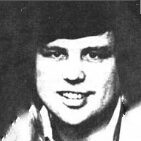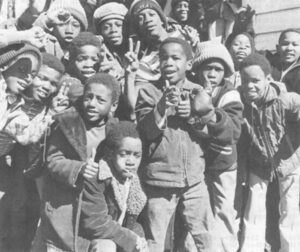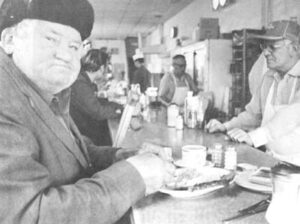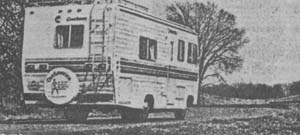Mike Masterson
- 1976

Fellowship Title:
- U.S.: The Conditions and Attitudes of its People in 1976
Fellowship Year:
- 1976

Our America: One Family in Search of a Nation
March 28, 1977
MONTGOMERY, Ala. — Winding the car along neighborhood streets, I watched the old, two-story white homes glide past. This had all the earmarks of a vintage city smack in the vitals of the deep South. There was some comfort in realizing we were back in the South again. It was a feeling I can’t describe except to say it was generated by a slower, less frantic pace. Here, people walked the streets like it didn’t matter if they were five minutes late. In the cafes they ate slower and there’s no need to describe the way folks drag out their words in a drawl. Not far from the gleaming state capitol dome and around a couple of corners from where Martin Luther King, Jr., once preached the message of human rights on Sunday mornings, I happened upon a federally-subsidized housing project. In the projects of Montgomery, Alabama You know the kind, identical, two-story red-brick buildings that spread for blocks. It’s the same place I’ve heard others call “the only sore spot on our nice little

Our America: One Family in Search of a Nation
February 10, 1977
HOT SPRINGS, Ark. — The drab exterior of Martin’s Recreation Center and Cafe isn’t much different than the inside, a 60-year-old brick building sandwiched between clothing and shoe shops along Central Avenue downtown. Those who don’t put much store in appearances venture behind the door each day into a world of self-proclaimed comedians and experts, along with amateur philosophers wearing everything from business suits to Salvation Army stock. The motley gathering takes form about seven in the morning and the exaggerations, comparisons and judgments continue until the doors are locked at 5:30. Martin’s could be the same place my grandfather used to take me twice a week, under another name in a different town 20 years ago. In that hole in the wall, a 50-cent bowl of chili and beans with crackers was the specialty. But despite good food, most men came to trade wit and join in continuing bull sessions. The Hot Springs cafe is a salty, colorful nook where Damon Runyan could have retired in bliss. It’s also a haven for nearly 200

Our America: One Family in Search of a Nation
January 5, 1977
GRAND JUNCTION, COLO. — When I was in school, a skinny geography professor with thick dark glasses used to talk about an infatuation with this western Colorado town. I could still hear him talking in a shrill voice about his fascination with the majesty of surrounding mountains and what a large number of services Grand Junction provided for such a small city. As most folks might do, I fantasized what Grand Junction would look like and, like most fantasies, the vision was unreal. Rumbling into the city of 20,200 from the west on Hwy. 50, we rolled past flat, mostly barren landscape. Grand Junction was nestled at the foot of a mountain pass, spread like a checkered table cloth across the brown flatlands. The KOA campground was close to the mountains on the other side of town and, after bedding down the Lady K, we made our way back into the city. The people we met in Grand Junction were all smiling and friendly. Downtown merchants had long ago converted their stores into an open

Our America: One Family in Search of a Nation
November 29, 1976
BARSTOW, Ca. — Motoring free from the nerve-tattering traffic of Los Angeles, we soon found ourselves keeping company with an ocean of sand, cactus and tumble weeds that raced each other across the desert swells. For seemingly endless miles the Lady K carried us toward one vanishing point after another. At one time Brandon aroused from his boredom to dart a forefinger toward an animal beside the road. “Look dad,” he shouted, “big dog.” But he was only part right. It was an emaciated coyote trying to cross the highway. It was the first living thing, other than humans in cars, we had seen for a hundred miles or more. There was, however, beauty amid the heat and desolation of the Mohave Desert. It is a beauty of shape and shadows and being able to see for 50 miles or more in any direction. This Arkie had long been reinforced to see the wonders of nature among the rolling green hills and clear running streams of my native state. But this was of equal majesty

Our America: One Family in Search of a Nation
October 18, 1976
Seattle, Wash. — The city of half a million is snuggled beneath the guardian eye of snow-capped Mount Rainier, a spectacular granite wonder that stretches for and grasps low lying clouds. The Lady K rested in the woods at the KOA campground near Tacoma while we three piled into our four-wheeled lifeboat early one morning and headed for the city’s heart, 35 miles north. From a distance, Seattle resembles most other large cities. Gray rectangles of concrete and stone rise above the landscape surrounded by ribbons of interstate and a swaying sea of brightly-colored tin, each spouting its foul-smelling charcoal exhaust into the air. But up close, along the sidewalks, the view changes. Seattle becomes a blend of old and new, of excitement and even romance. Steep hills traverse the inner city resembling San Francisco, and the sea gull’s cry overhead adds another dimension of charm. Brandon stood in awe as the futuristic monorail whizzed by above, past red-brick buildings that had to be a century old. Seattle — from the Needle…monorail track (center) leads
